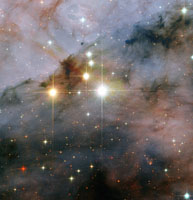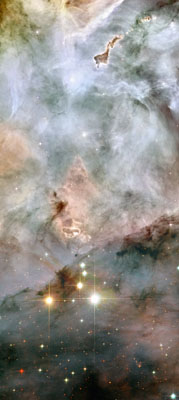
Hubble Captures Views of Mammoth Stars
25 November 2008
Two of our galaxy's most massive stars, until recently shrouded in mystery, have been viewed by the NASA/ESA Hubble Space Telescope, unveiling greater detail than ever before.
|
Mammoth stars seen by Hubble
|
The image shows a pair of colossal stars, WR 25 and Tr16-244, located within the open cluster Trumpler 16. This cluster is embedded within the Carina Nebula, an immense cauldron of gas and dust that lies approximately 7500 light-years from Earth. The Carina Nebula contains several ultra-hot stars, including these two star systems and the famous blue star Eta Carinae, which has the highest luminosity yet confirmed.
These stars are very bright and they produce incredible amounts of heat, emitting most of their radiation in the ultraviolet and appearing blue in colour. They are so powerful that they burn through their hydrogen fuel source faster than other types of stars, leading to a ‘live fast, die young’ stellar lifestyle.
WR 25 is the brightest, situated near the centre of the image. The neighbouring Tr16-244 is the third brightest, just to the upper left of WR 25. The second brightest, to the left of WR 25, is a low-mass star located much closer to Earth than the Carina Nebula. Stars like WR 25 and Tr16-244 are relatively rare compared to other, cooler types. They interest astronomers because they are associated with star-forming nebulae, and influence the structure and evolution of galaxies.
|
The multiple-star system of Tr16-244
|
Massive stars are usually formed in compact clusters. Often, the individual stars are physically so close to each other that it is very difficult to resolve them in telescopes as separate objects. These Hubble observations have revealed that the Tr16-244 system is actually a triple star.
|
Wide-field image showing the region of WR 25 and Tr16-244
|
WR 25 and Tr16-244 are the likely sources of radiation that is causing a giant gas globule within the Carina Nebula to slowly evaporate away into space, while possibly inducing the formation of new stars within it (see separate image). The radiation is also thought to be responsible for the globule's interesting shape, prominently featured in earlier Hubble images, which looks like a hand with a ‘defiant’ finger pointing towards WR 25 and Tr16-244.
These new observations were obtained by a team including astronomers from US, Chilean, Spanish, and Argentinian institutions and led by Jesús Maíz Apellániz from the Instituto de Astrofísica de Andalucía in Spain. They are using Hubble along with ground-based observatories in Spain, Chile, and Argentina to build a comprehensive catalogue of observations of all the massive stars in the Galaxy that are detectable at visible wavelengths.
The Hubble Space Telescope is a project of international cooperation between NASA and ESA.
Jesús Maíz Apellániz, Instituto de Astrofísica de Andalucía, Spain
E-mail: Jmaiz @ iaa.es
Lars Lindberg Christensen, Hubble/ESA, Garching, Germany
E-mail: Lars @ eso.org
www.esa.int/esaCP/SEMWHR5DHNF_index_0.html



